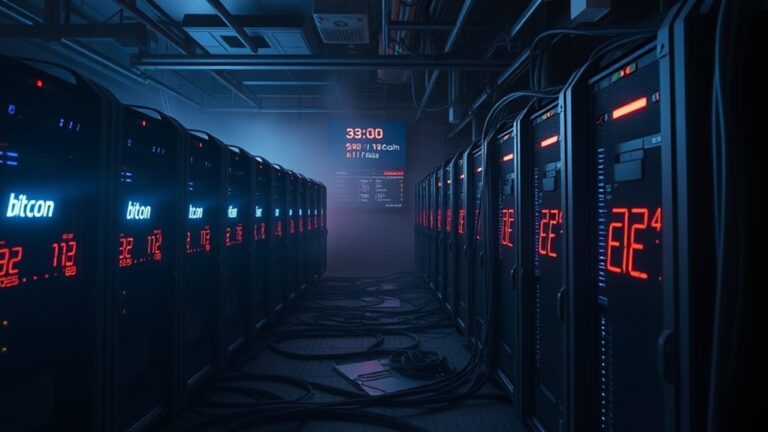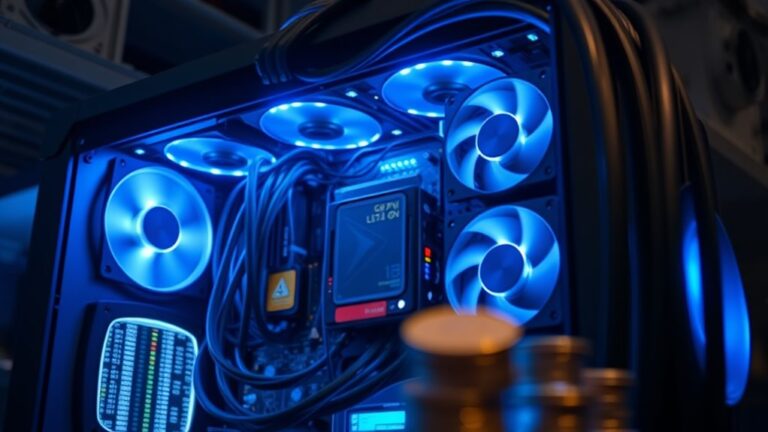
Ethereum Mining Before PoS Upgrade: How It Worked and Its Impact
Before the change to proof-of-stake, Ethereum mining operated on a proof-of-work model, allowing miners to verify transactions and secure the network. They used GPUs, which are more efficient than CPUs, to solve complex mathematical problems. Successful miners earned rewards in Ether and gas fees while contributing to network security. However, this system resulted in high energy consumption and limited scalability. Understanding these mechanics highlights the significant impact of Ethereum’s shift to a more sustainable model.
Key Takeaways
- Ethereum mining used the Ethash algorithm, favoring GPU mining for its memory-hard design over ASIC miners, ensuring a decentralized mining environment.
- Miners verified transactions and created new blocks, earning 2 ETH plus gas fees as rewards for their computational efforts.
- Mining profitability fluctuated based on ETH prices, energy costs, and network competition, leading miners to explore alternative cryptocurrencies when profits declined.
- The high energy consumption and environmental impact of proof-of-work mining raised concerns about sustainability and electronic waste within the Ethereum network.
- Scalability issues arose from network congestion and limited capacity, prompting the need for a shift to more efficient consensus mechanisms like proof-of-stake.
The Mechanics of Ethereum Mining

Ethereum mining involves a series of complex processes that are essential for maintaining the integrity and functionality of the Ethereum blockchain.
This process requires miners to use computing power to verify transactions and create new blocks. Miners solve intricate mathematical problems through the Ethash algorithm, which is designed to be memory-hard, promoting GPU mining over ASICs.
Miners utilize computing power to verify transactions and create new blocks by solving complex problems with the Ethash algorithm.
When a miner successfully solves a problem, they add a new block to the blockchain and receive rewards in Ether, consisting of block rewards and transaction fees.
The mining process also secures the network against potential attacks, as the difficulty of these problems adjusts based on network conditions to guarantee consistent block times, averaging around 15 seconds for Ethereum transactions. This ensures that the network remains resilient against fraudulent activities while maintaining the integrity of the blockchain.
Key Hardware Used for Mining

Mining hardware plays an essential role in the process of extracting Ether from the Ethereum blockchain, greatly influencing mining efficiency and profitability.
Various types of hardware are employed in Ethereum mining, each with distinct characteristics:
- CPU vs. GPU: CPUs are less efficient than GPUs, which dominate the mining landscape.
- Popular GPU Models: Models such as NVIDIA GeForce GTX1070 and AMD Radeon RX580 are commonly used.
- ASIC Miners: Specialized ASIC hardware is generally not utilized for Ethereum mining.
- Essential Components: A mining rig typically includes a motherboard, power supply, cooling system, and multiple GPUs.
- Cost and Complexity: Building a mining rig can be costly and requires a certain level of technical expertise.
Understanding these components is vital for anyone interested in Ethereum mining. Additionally, having a balanced approach to power consumption and computational performance ensures maximized profitability in the mining process.
Rewards and Profitability Trends

While the landscape of cryptocurrency mining has evolved considerably, the rewards and profitability trends associated with Ethereum mining have been closely linked to various factors.
Miners earned rewards through block creation, receiving a primary block reward of 2 ETH plus gas fees from transactions. Profitability fluctuated markedly based on the price of ETH, energy costs, and competition among miners.
As hash rates increased, profitability could rise, but higher network difficulty often required more advanced hardware. In 2021, mining profits surged due to high ETH prices, but by mid-2022, declining prices led to decreased profitability. This volatility made long-term planning challenging, prompting some miners to explore alternative cryptocurrencies as profitability waned.
Looking ahead, miners will need to consider renewable energy sources to enhance profitability in a competitive environment.
Environmental and Scalability Challenges

Numerous environmental and scalability challenges plagued the Ethereum network prior to its shift to a proof-of-stake (PoS) model. The reliance on proof-of-work (PoW) led to significant energy consumption and contributed to carbon emissions.
Additionally, the rapid pace of technology advances resulted in considerable electronic waste. The network also faced scalability issues, hindering its transaction capacity and speed.
Key challenges included:
- High energy consumption from mining operations
- Significant carbon emissions from non-renewable sources
- Network congestion affecting transaction processing
- Limited capacity compared to traditional systems
- Increased competition from other scalable blockchains
These challenges highlighted the urgent need for Ethereum to explore more sustainable and efficient solutions to enhance its operations and environmental impact. Implementing sustainable mining techniques could reduce the network’s negative footprint and improve overall efficiency.
The Transition to Proof of Stake and Its Implications

The shift from proof-of-work (PoW) to proof-of-stake (PoS) marked a notable turning point for the Ethereum network, effectively completing “The Merge” on September 15, 2022.
This alteration replaced the energy-intensive mining process with a staking system, which enhances sustainability and security. The integration of the Beacon Chain with the main Ethereum network facilitated this change.
In the PoS model, validators must stake 32 ETH and are randomly chosen to validate transactions and propose new blocks, earning rewards in the process.
While this upgrade considerably reduces energy consumption and improves scalability, it also raises concerns about centralization, as larger entities dominate staking. Furthermore, the evolving landscape of crypto mining is influencing how stakeholders assess the future of blockchain technology and its energy consumption.
Frequently Asked Questions
What Is the History of Ethereum Mining Before the Pos Upgrade?
Ethereum mining began with the Proof-of-Work model in 2015, requiring complex calculations and specialized hardware. This energy-intensive process secured transactions, provided rewards, but faced criticism for environmental impact and scalability limitations before shifting to Proof-of-Stake.
How Did Mining Difficulty Affect Miners’ Strategies?
Mining difficulty greatly influenced miners’ strategies, prompting shifts to pool mining for resource efficiency, diversification into alternative cryptocurrencies, and ultimately necessitating hardware upgrades or changes towards staking as profitability diminished over time.
What Were the Key Challenges for Beginner Miners?
Approximately 80% of beginner miners faced significant challenges, including high initial investments, complex hardware setups, and fluctuating market conditions. These obstacles often hindered their ability to achieve profitability and maintain efficient mining operations in a competitive environment.
How Did Regulatory Changes Impact Ethereum Mining?
Regulatory changes greatly impacted Ethereum mining by introducing energy consumption regulations, income tax obligations, and varying global legal statuses, prompting miners to adapt through self-regulation while facing challenges from evolving frameworks concerning environmental concerns and economic viability.
What Communities Formed Around Ethereum Mining Activities?
In the bustling marketplace of Ethereum mining, communities thrived like guilds of ancient craftsmen, sharing knowledge and strategies. Through forums and collaborative pools, miners united, exchanging advice and resources to maximize efficiency and rewards in their pursuits.
Conclusion
In summary, Ethereum mining operated like a race, where miners competed to solve complex puzzles using powerful hardware. This competition yielded rewards but also posed significant environmental challenges and scalability issues. The change to Proof of Stake marked a pivotal change, akin to moving from racing gas-guzzling cars to efficient electric vehicles. This new approach aims to reduce energy consumption and improve network performance, fundamentally altering how Ethereum functions while addressing some of the pressing concerns of its mining past.












